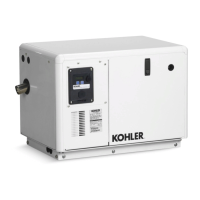
 Loading...
Loading...




Do you have a question about the Kohler 6EKOD and is the answer not in the manual?
| AC Frequency | 60 Hz |
|---|---|
| Genset Power Rating | 6kW |
| Fuel Type | Diesel |
| Power Output | 6000 W |
| Engine Type | 4-cycle |
Main category of products covered by this service manual.
Section for recording generator set identification numbers for service.
Section for recording engine identification numbers for service.
Procedures to prevent accidental generator set starting and associated hazards.
Warnings and precautions regarding fire hazards related to the engine and fuel.
Safety warnings concerning exhaust gases, carbon monoxide, and system integrity.
Safety precautions for handling fuel, preventing vapor ignition, and ensuring fuel system integrity.
Warning about potential hearing damage from generator noise and muffler requirements.
Warnings about electrical hazards, grounding, and dangers from moving parts.
Caution regarding hot engine components like coolant and steam, and safe pressure cap removal.
Important notes on fuse replacement, saltwater damage, and general equipment care.
Information on contacting Kohler for technical support, service, and parts.
Overview of generator set models covered and general operational ratings.
Detailed technical specifications for the generator set engines.
Electrical specifications for 4-lead generator configurations.
Electrical specifications for 12-lead generator configurations.
Diagrams identifying key components and their locations on the generator set.
Recommended torque values for various fasteners and components during assembly.
Guidelines for routine maintenance scheduling and precautions for seawater environments.
Recommendations for engine oil selection based on API and SAE standards for optimal lubrication.
Procedures for inspecting the exhaust system for leaks, blockages, and carbon monoxide hazards.
Steps for checking and cleaning the exhaust mixing elbow for carbon buildup and corrosion.
Description of typical fuel system arrangements and considerations for low fuel conditions.
Procedure for replacing the fuel filter element to maintain fuel cleanliness.
Method for bleeding air from the fuel system to prevent rough running or vapor lock.
Procedure for testing the fuel pump's operation and verifying output pressure.
Information on the mechanical governor's function in maintaining engine speed under load.
Description of the 2-lead fuel solenoid and its role in fuel flow control.
Overview of the heat exchanger cooling system components and their functions.
Description of the water-cooled exhaust manifold and thermostat location within it.
Procedure for draining, cleaning, and servicing the heat exchanger to maintain cooling efficiency.
Instructions for checking and filling the engine coolant level with the correct mixture.
Procedure for flushing and cleaning the cooling system to remove contaminants and ensure optimal performance.
Information on the pressure cap's function in raising boiling points and its replacement criteria.
Procedure for inspecting and replacing the seawater pump impeller for cooling system operation.
Guidelines for checking and adjusting belt tension to ensure proper component operation.
Specific steps for adjusting the seawater pump belt tension correctly.
Procedure for checking and replacing the anticorrosion zinc anode to prevent electrolytic corrosion.
Procedure for inspecting the siphon break mechanism to prevent seawater entry into the engine.
Guidance on troubleshooting procedures and the importance of professional service.
Basic checks for common problems like connections, battery, and fuses before component replacement.
A comprehensive chart listing problems, possible causes, corrective actions, and references for diagnosis.
Overview of the ADC IId controller's operation, configuration, adjustment, and replacement.
General guidelines for controller repair, software updates, and verifying connections.
PC requirements and resources for using the SiteTecht software for controller configuration.
Procedure for replacing the ADC IId controller, including configuration verification.
Details on the controller's interface, controls, indicators, and operational modes.
Information about the USB communication ports for PC connections and mass storage devices.
Identification and function of fuses located on the junction box for circuit protection.
Description of the preheat relays that power the engine glow plugs for cold starting.
Function of the battery charging module in maintaining the starting battery voltage.
Details on inhibit and time delays for fault shutdowns and warnings, and their specifications.
Guide to understanding the controller's menu structure, navigation, and selectable options.
Instructions for accessing controller data via display or PC.
Guide to navigating and understanding controller menu displays, including error messages.
Explains the basic principles of generator operation and how AC voltage is produced and regulated.
Procedure for testing generator output using an external voltage source to diagnose issues.
Test procedure for the exciter field resistance and short-to-ground conditions.
Test procedure for the exciter armature resistance and short-to-ground conditions.
Guidelines for inspecting and cleaning slip rings for proper brush contact.
Information on brush inspection, positioning, and resistance checks for optimal current transfer.
Test procedure for the rectifier module diodes to ensure AC to DC conversion.
Test procedure for the generator rotor main field resistance and short-to-ground conditions.
Test procedure for stator continuity and short-to-ground conditions to ensure winding integrity.
Details on voltage regulator specifications, adjustments, and calibration procedures.
Details on the controller's voltage regulation function and calibration requirements.
Explanation of voltage adjustment, underfrequency unload, and gain settings for performance tuning.
Displays voltage regulator adjustment, volt/Hz, gain, and stability values for fine-tuning.
Procedures for changing generator set output voltage by reconnecting leads.
Illustrates reconnection procedures for four-lead generator sets for different voltage configurations.
Wiring configurations for 100-120 volt systems using circuit breakers and appropriate wiring.
Wiring configurations for 100-120/200-240 volt systems, detailing circuit breaker selection.
Wiring configurations for 200-240 volt systems, including circuit breaker and jumper lead usage.
Procedure for reconnecting 12-lead generator sets for voltage changes and frequency adjustments.
Tests to verify the operation of generator set fault shutdown functions like overspeed and low oil pressure.
Tests to verify operation of overspeed, overcrank, and temperature shutdowns via controller logic.
Procedures for testing oil pressure and seawater pressure sensors/switches for accurate shutdown signaling.
Procedure for testing the coolant temperature sensor resistance at various temperatures.
Information on the high exhaust temperature shutdown switch and its activation point.
Identification and function of fuses in the control box, including their protective roles.
Procedures for checking continuity of various circuit components using an ohmmeter.
Step-by-step instructions for safely disassembling the generator set and its components.
Procedure for replacing collector rings and bearings on specific 6EKOD/5EFKOD models.
Step-by-step instructions for correctly reassembling the generator set after maintenance.
Table referencing point-to-point and schematic wiring diagrams for various models.
Wiring diagrams for manual transfer switches with 2 and 3 wire configurations for shore power selection.
Wiring diagrams for manual transfer switches with 4 wire configurations for shore power selection.
List of abbreviations used throughout the manual for clarity.
Guidelines for applying common hardware and fasteners, ensuring correct assembly techniques.
General torque specifications for American Standard and Metric fasteners used in assembly.
Visual guide for identifying common hardware head styles, nuts, and washers for proper selection.
Part numbers and dimensions for common hardware items, facilitating procurement and replacement.